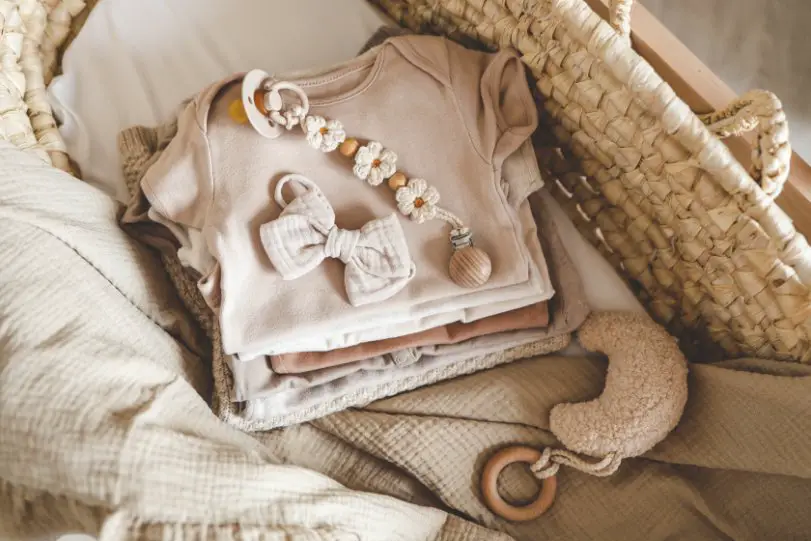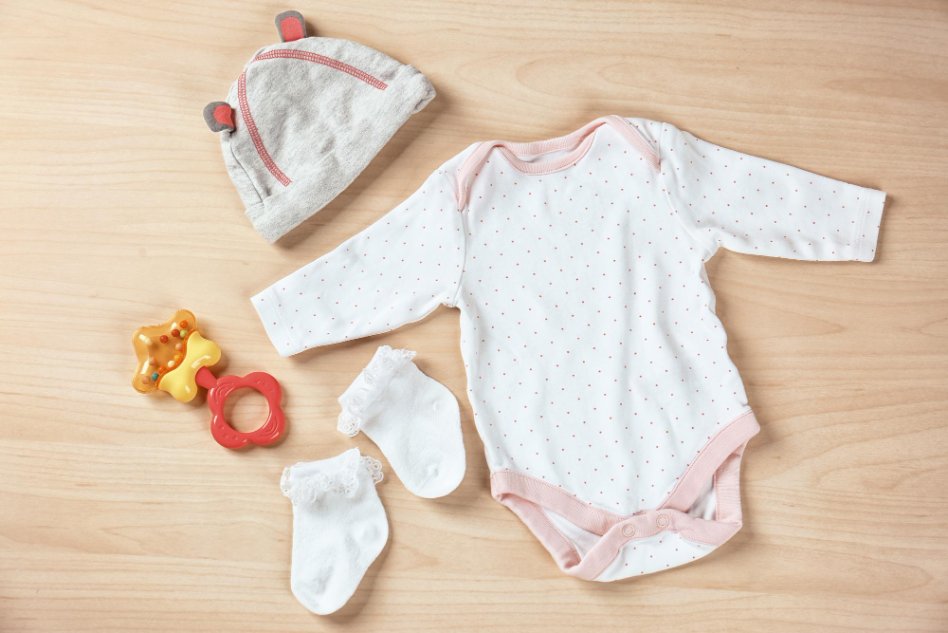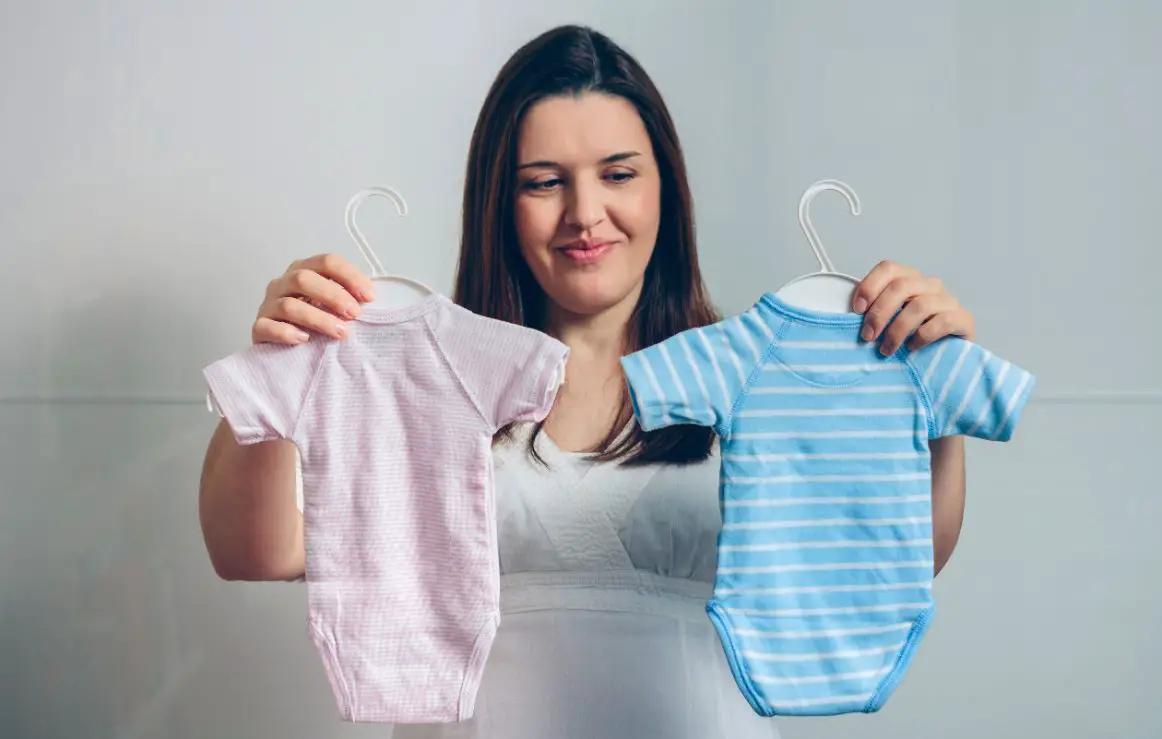A comprehensive guide to making informed decisions about your baby’s clothing for health, comfort, and environmental impact
Table of Contents
- Understanding Organic vs. Conventional Materials
- Health and Safety Considerations
- Environmental Impact of Clothing Production
- Smart and Tech-Enhanced Baby Clothing
- Certification and Standards
- Complete Sizing and Fit Guide
- Caring for Organic Infant Clothing
- Economic Implications
- Alternative Sustainable Materials
- Consumer Guide to Buying Infant Clothes
- Frequently Asked Questions
- Conclusion
Key Takeaway: Organic cotton baby clothes are made without harmful pesticides and chemicals, offering potential health benefits for babies with sensitive skin while reducing environmental pollution. This comprehensive guide will help you make informed choices about your infant’s clothing needs.
Choosing between organic and conventional baby clothing can feel overwhelming for new parents. The debate centers on pesticide use, textile processing, and overall environmental impact. With so many options available, understanding the differences between natural and synthetic fabrics becomes crucial for making the best decisions for your little one.
Modern parents are increasingly conscious about what touches their baby’s delicate skin. Conventional cotton uses more chemicals during both growing and manufacturing processes, which can remain in the fabric and potentially irritate sensitive skin. Organic cotton production, though more expensive, uses natural farming methods that benefit farmers, consumers, and our planet.
Understanding Organic vs. Conventional Materials
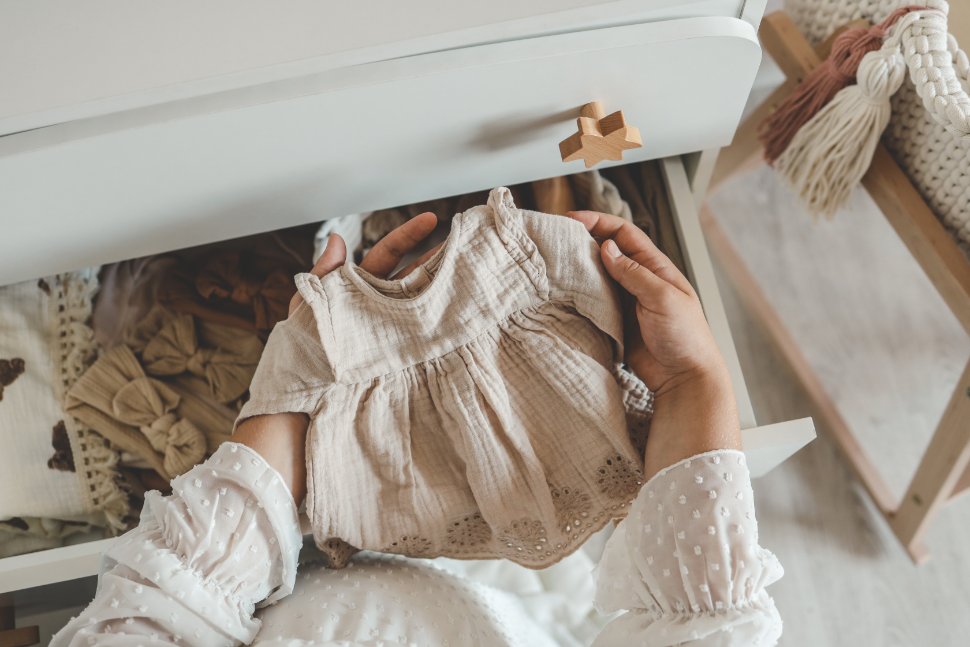
Baby clothing materials differ greatly based on how they’re grown and processed. These differences impact both our planet and babies’ sensitive skin. Understanding what makes fabrics organic or conventional helps parents make informed choices about their infant’s wardrobe.
What Makes Baby Clothing Organic?
Organic baby clothing is made from materials grown without synthetic pesticides, fertilizers, or genetically modified organisms (GMOs). Organic cotton, the most common organic fabric, is cultivated using natural methods that protect soil health and biodiversity.
For fabrics to be truly organic, they must be certified by organizations like GOTS (Global Organic Textile Standard). This ensures the entire production process meets strict environmental and social criteria. The certification process also verifies that no harmful chemicals were used during manufacturing. You can verify authentic GOTS certification through the official GOTS website.
Other organic fabric options include:
- Organic bamboo
- Organic hemp
- Organic wool
- Organic linen
Is organic clothing better for babies?
Research consistently shows that organic clothing offers several advantages for infants. Babies have thinner, more permeable skin than adults, making them more susceptible to chemical absorption. Organic fabrics eliminate exposure to pesticide residues, synthetic dyes, and harsh processing chemicals that can trigger skin reactions or allergies.
Pediatric dermatologists often recommend organic clothing for babies with eczema or sensitive skin conditions. The absence of chemical treatments means organic fabrics maintain their natural breathability and softness, helping regulate body temperature more effectively than conventional alternatives. The American Academy of Pediatrics notes that infant skin is particularly vulnerable to chemical absorption due to its thinner, more permeable nature.
Not sure which organic fabric is right for your baby? Take our interactive organic fabric quiz to get personalized recommendations based on your baby’s specific needs and your lifestyle.
Understanding Conventional Baby Clothing
Conventional baby clothing typically uses standard cotton or synthetic materials produced with chemical fertilizers, pesticides, and insecticides. The conventional cotton industry uses about 25% of the world’s insecticides and 10% of pesticides globally, despite cotton occupying only 2.5% of agricultural land.
Processing conventional fabrics often involves:
- Formaldehyde (to prevent wrinkles)
- Chemical dyes containing heavy metals
- Synthetic finishes for stain resistance
- Flame retardants
- Bleaching agents
These treatments help create clothes that cost less and may resist stains or wrinkles better. However, residues from these chemicals can remain in the fabric and potentially irritate a baby’s sensitive skin.
What kind of clothing is best for infants?
The best infant clothing combines safety, comfort, and practicality. Natural fabrics like organic cotton top the list because they’re gentle on sensitive skin, breathable, and free from harmful chemicals. Look for clothing with flat seams, easy-access snaps, and envelope necklines that make dressing easier.
Essential features for infant clothing include:
- Soft, non-irritating fabrics
- Easy-to-use fasteners
- Machine washable materials
- Proper fit with room for movement
- Safety certifications
Material Comparison Chart
| Feature | Organic Fibers | Conventional Fibers |
|---|---|---|
| Growing method | Natural fertilizers, no synthetic pesticides | Chemical fertilizers, synthetic pesticides |
| Environmental impact | Lower water usage, better soil health | Higher water usage, soil degradation |
| Processing | Minimal chemicals, natural dyes | Numerous chemicals, synthetic dyes |
| Skin sensitivity | Lower risk of irritation | Higher risk of allergic reactions |
| Durability | Often more durable due to stronger fibers | May break down faster with washing |
| Cost | Typically 20-30% higher upfront cost | Usually less expensive initially |
Organic materials feel softer against the skin because they aren’t treated with harsh chemicals. They also tend to be more breathable, which helps regulate baby’s body temperature. While conventional fabrics cost less initially, organic options often last longer, making the higher initial price worthwhile for many families.
Health and Safety Considerations
When choosing between organic and conventional baby clothing, parents should consider how different fabrics might affect their little one’s health. Babies have more sensitive skin and developing systems that can be more vulnerable to irritants and chemicals found in some clothing.
Skin Irritation and Allergies
Babies have delicate skin that’s thinner and more permeable than adult skin. This makes them more susceptible to irritants in fabrics. Organic cotton is grown without harsh pesticides that can remain in fabric fibers and potentially trigger skin reactions.
Parents often report that babies with eczema or sensitive skin show improvement when wearing organic clothes. Conventional cotton processing can leave behind residues that might cause redness, rashes, or discomfort. The gentle nature of organic fabrics makes them ideal for newborns whose skin barrier is still developing.
What is the healthiest material for baby clothes?
Organic cotton stands out as the healthiest material for baby clothes. It’s grown without pesticides, processed without harsh chemicals, and maintains natural breathability. Organic bamboo is another excellent choice, offering natural antibacterial properties and exceptional softness. These materials undergo minimal chemical processing, reducing the risk of skin irritation and allergic reactions.
Other healthy fabric options include:
- Organic merino wool (temperature regulating)
- Organic hemp (naturally antimicrobial)
- Organic linen (highly breathable)
- TENCEL (made from sustainably sourced wood)
Harmful Chemicals and Their Effects
Conventional baby clothing can contain several concerning chemicals. Formaldehyde is sometimes used to create “wrinkle-free” finishes but can cause respiratory issues and skin irritation in sensitive individuals. Some baby clothes contain flame retardants, which sound beneficial but can disrupt hormone function and accumulate in a baby’s system.
Bleach and synthetic dyes used in conventional clothing may contain heavy metals that can be absorbed through skin. Parents should look for GOTS (Global Organic Textile Standard) certification on organic baby clothing, which ensures the entire production process meets strict environmental and toxicological criteria.
What to avoid with baby clothes?
Parents should avoid several elements when choosing baby clothes. Synthetic fragrances, formaldehyde finishes, and flame retardant chemicals top the list of harmful substances. Also avoid clothes with loose buttons, long strings, or rough seams that could cause injury. Flame retardant treatments in sleepwear should be avoided in favor of snug-fitting organic alternatives.
Substances to Avoid in Baby Clothing:
- Formaldehyde-based wrinkle treatments
- Heavy metals in dyes (lead, cadmium)
- Synthetic fragrances and perfumes
- Phthalates in prints and designs
- Chlorine bleaching residues
- Volatile organic compounds (VOCs)
Should I use non-bio for baby clothes?
Non-biological (non-bio) detergents are generally recommended for baby clothes because they don’t contain enzymes that can irritate sensitive skin. These detergents are formulated to be gentler while still providing effective cleaning. However, the choice between bio and non-bio detergent matters less than choosing a detergent free from fragrances, dyes, and harsh chemicals.
When washing baby clothes, consider these guidelines:
- Use fragrance-free, hypoallergenic detergents
- Avoid fabric softeners which can reduce absorbency
- Wash new clothes before first wear
- Use extra rinse cycles to remove detergent residue
Environmental Impact of Clothing Production
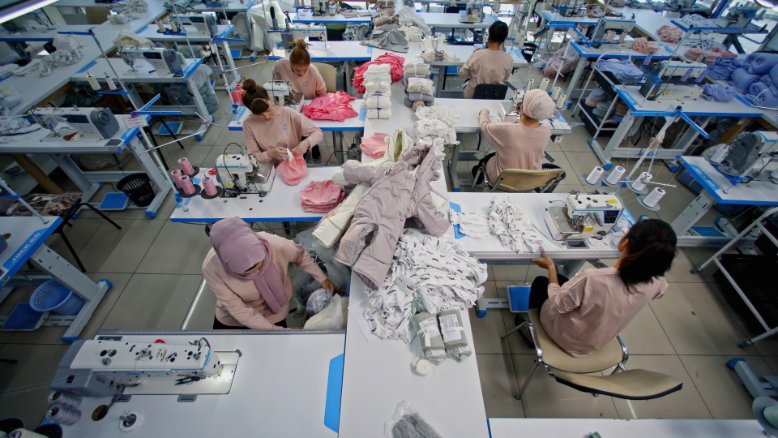
Clothing production creates significant environmental challenges from farm to factory. The choices between organic and conventional methods affect ecosystems, water quality, and overall sustainability in the infant clothing industry.
Organic Farming and Biodiversity
Organic cotton farming supports biodiversity by eliminating synthetic chemicals that harm beneficial insects and soil organisms. These farms typically host 50% more plant species and 30% more animal species compared to conventional cotton fields.
Organic farming practices build healthier soil through crop rotation and natural fertilizers. This improved soil structure retains more water, reducing irrigation needs by up to 30%. The absence of chemical inputs creates safe habitats for pollinators like bees and butterflies, which are essential for maintaining balanced ecosystems.
Pesticide Use in Cotton Farming
Conventional cotton farming is chemical-intensive, using about 16% of the world’s insecticides despite occupying just 2.5% of agricultural land. These pesticides contaminate water sources and harm wildlife in surrounding areas. Workers on conventional farms face serious health risks from chemical exposure, with studies showing increased rates of respiratory problems and certain cancers in farming communities.
Pesticide residues can remain in finished cotton products, potentially contacting babies’ sensitive skin. Organic cotton eliminates these chemicals from the production process entirely, creating a safer product for infants and protecting agricultural workers.
Sustainability in Fabric Manufacturing
The manufacturing process for conventional baby clothing often involves harsh chemical treatments, dyes, and finishes that generate toxic wastewater. These chemicals can include formaldehyde, heavy metals, and phthalates that persist in the environment.
Organic manufacturing prioritizes:
- Low-impact dyes and natural coloring agents
- Closed-loop water systems that recycle up to 95% of water used
- Energy-efficient equipment that reduces carbon footprint
- Biodegradable packaging materials
Many sustainable manufacturers are adopting blockchain technology to track environmental impacts throughout the supply chain. This transparency allows parents to make fully informed choices about their baby’s clothing.
Smart and Tech-Enhanced Baby Clothing
The Future of Baby Clothing: Smart Organic Fabrics
The baby clothing industry is evolving to incorporate technology while maintaining the benefits of organic materials. Smart baby clothing represents an exciting intersection of health monitoring and sustainable fashion.
Smart baby clothing with built-in sensors is gaining popularity among tech-savvy parents. These innovative garments can monitor vital signs, sleep patterns, and even detect diaper wetness while maintaining the comfort and safety of organic fabrics.
Technology Integration in Organic Clothing
Modern smart baby clothes use flexible, washable sensors embedded in organic cotton or bamboo fibers. These sensors can track:
- Heart rate and breathing patterns
- Body temperature regulation
- Sleep quality and duration
- Movement and developmental milestones
- Environmental conditions (room temperature, humidity)
The integration of technology doesn’t compromise the organic nature of the fabric. Sensors are typically made from biocompatible materials and are designed to be removable for washing or completely washable themselves.
Benefits and Considerations
Smart organic baby clothing offers several advantages for new parents. Real-time health monitoring can provide peace of mind, especially for premature babies or those with health concerns. The data collected can help parents establish better sleep routines and identify potential health issues early.
However, parents should consider privacy implications and the potential for over-monitoring. The technology should supplement, not replace, parental intuition and regular pediatric care. Costs for smart clothing typically range from $50-200 per garment, making them a significant investment compared to traditional organic options.
Certification and Standards
When shopping for infant clothing, certifications help parents identify safer options. These standards ensure clothes meet specific health, environmental, and ethical requirements.
Global Organic Textile Standard (GOTS)
GOTS is considered the highest standard for organic textiles. This certification covers the entire production process from seed to finished product, including packaging. For baby clothes, this means fabrics that are free from harmful chemicals and pesticides.
GOTS-certified organic cotton is grown without synthetic pesticides or fertilizers, making it gentler on a baby’s sensitive skin and reducing the risk of allergic reactions. The certification requires:
- At least 95% certified organic materials
- No toxic heavy metals or formaldehyde
- Restricted use of synthetic sizing agents
- Environmentally responsible manufacturing processes
- Fair labor practices throughout the supply chain
OEKO-TEX Certification
OEKO-TEX Standard 100 is another important certification for baby clothing. Unlike GOTS, it doesn’t require fabrics to be organic but focuses on testing for harmful substances. This certification ensures that every component of the garment has been tested for harmful chemicals.
Products with this label are free from substances known to harm human health, including:
- Pesticide residues
- Heavy metals
- Formaldehyde
- Colorants that may cause allergies
- Chlorinated phenols
Other Important Certifications
Several other certifications provide valuable assurance for parents:
- Cradle to Cradle Certified: Ensures products are safe for humans and environment throughout their lifecycle
- GREENGUARD Gold: Tests for low chemical emissions
- Fair Trade Certified: Ensures ethical labor practices and fair wages
- Organic Content Standard (OCS): Verifies organic fiber content in products
Complete Sizing and Fit Guide
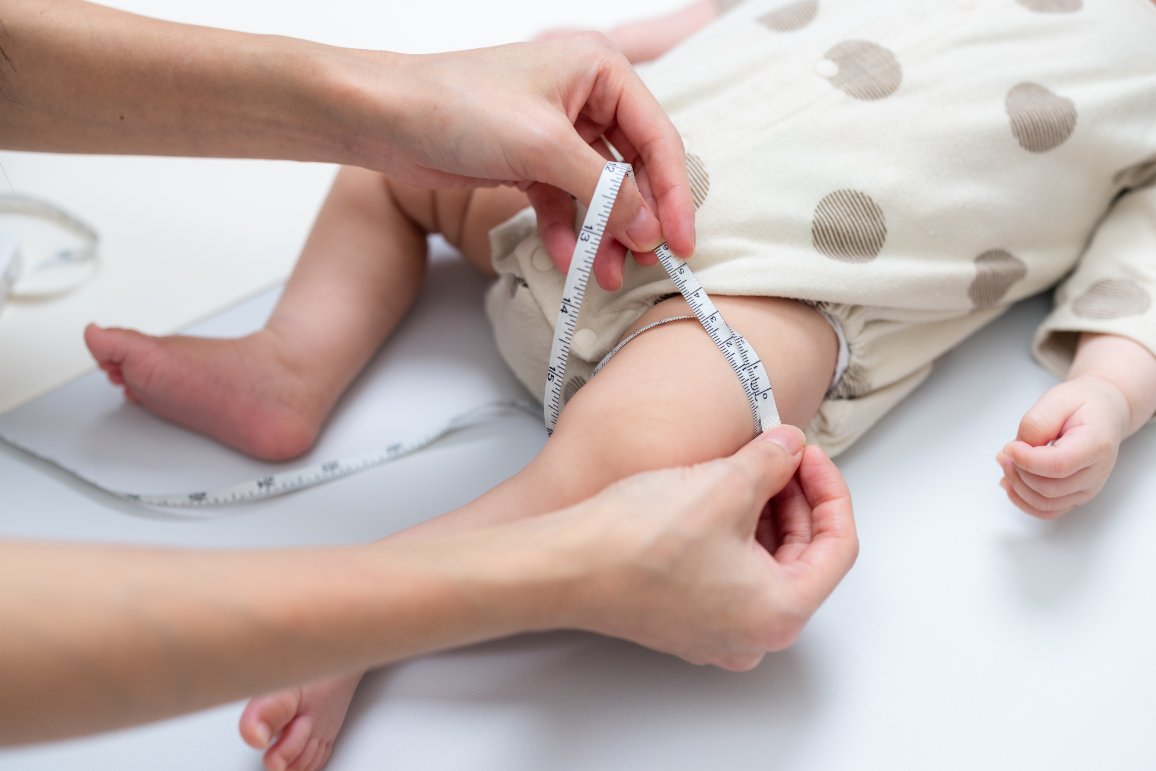
Getting the right size for baby clothes can be challenging, especially since babies grow so quickly. Understanding how infant clothing sizes work helps ensure proper fit and value for money.
Understanding Baby Clothing Sizes
Baby clothing sizes are typically based on age ranges, but actual fit depends on the baby’s weight and height. Newborn sizes generally fit babies weighing 5-8 pounds and measuring up to 21.5 inches long. According to the CDC Growth Charts, tracking your baby’s growth measurements helps ensure proper clothing fit.
Most brands use the following age-based sizing:
- Preemie (P): Under 5 pounds, up to 17 inches
- Newborn (NB): 5-8 pounds, up to 21.5 inches
- 0-3 months: 8-12 pounds, 21.5-24 inches
- 3-6 months: 12-16 pounds, 24-26.5 inches
- 6-9 months: 16-20 pounds, 26.5-28.5 inches
Comprehensive Size Chart
| Size | Age Range | Weight (lbs) | Height (inches) | Chest (inches) |
|---|---|---|---|---|
| Preemie | 0-1 month | Up to 5 | Up to 17 | 14-15 |
| Newborn | 0-1 month | 5-8 | 17-21.5 | 16-17 |
| 0-3M | 0-3 months | 8-12 | 21.5-24 | 17-18 |
| 3-6M | 3-6 months | 12-16 | 24-26.5 | 18-19 |
| 6-9M | 6-9 months | 16-20 | 26.5-28.5 | 19-20 |
Brand Variations and International Sizing
Different brands size their clothing differently, so it’s important to check each brand’s specific size chart. European sizing uses centimeters based on the baby’s height, while US sizing typically uses age ranges.
European to US Size Conversion:
- Size 50-56 cm = Newborn
- Size 62 cm = 0-3 months
- Size 68 cm = 3-6 months
- Size 74 cm = 6-9 months
- Size 80 cm = 9-12 months
Practical Sizing Tips
When buying baby clothes, especially organic options that represent a higher investment, consider these practical guidelines:
Smart Sizing Strategies:
- Buy one size up for longer wear
- Focus on weight rather than age for better fit
- Consider the season when baby will wear the clothes
- Account for potential shrinkage after washing
- Keep receipts and tags for exchanges
- Measure your baby regularly for accurate sizing
How Many Clothes Does a Baby Need?
The quantity of clothes needed depends on your laundry frequency and lifestyle. For newborns, plan for multiple outfit changes daily due to spit-up and diaper accidents. Here’s a practical guide for essential clothing items:
- Onesies/Bodysuits: 8-10 in each size
- Sleepers/Pajamas: 6-8 pairs
- Pants/Leggings: 4-6 pairs
- Socks: 8-10 pairs
- Hats: 2-3 (organic cotton preferred)
- Swaddles/Receiving blankets: 4-6
Use our comprehensive organic baby clothes checklist by age to ensure you have everything your little one needs for each developmental stage, from newborn through toddler years.
Caring for Organic Infant Clothing
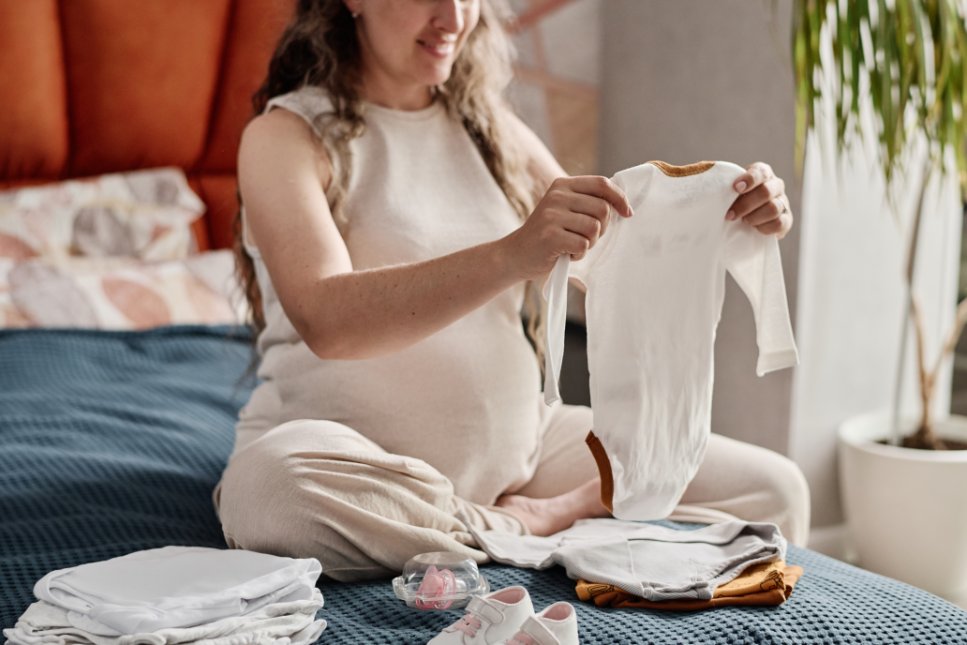
Proper care of organic baby clothing helps maintain their quality and extends their usability. Gentle washing methods and careful storage are essential for preserving these eco-friendly garments.
Best Practices for Washing Organic Baby Clothes
Always wash organic baby clothes before the first use to remove any processing residues. Cold or lukewarm water works best, as hot water can damage natural fibers and cause shrinkage. Use mild, plant-based detergents specifically formulated for sensitive skin.
Step-by-Step Washing Guide:
- Pre-treat stains immediately with a paste of baking soda and water
- Sort by color and fabric type to prevent bleeding
- Use cold water (30°C/86°F or less) to preserve fibers
- Choose gentle cycle with minimal agitation
- Use fragrance-free detergent designed for sensitive skin
- Add extra rinse cycle to remove all detergent residue
- Air dry when possible or use low heat setting
Is non-bio better for baby clothes?
Non-biological detergents are often preferred for baby clothes because they don’t contain enzymes that can potentially irritate sensitive skin. However, many modern bio detergents are formulated to be gentle enough for babies. The most important factors are choosing detergents that are:
- Free from fragrances and dyes
- Hypoallergenic and dermatologically tested
- Made with plant-based ingredients
- Concentrated to reduce packaging waste
Stain Removal for Organic Fabrics
Organic fabrics can be more sensitive to harsh stain removers, so natural methods work best:
| Stain Type | Natural Treatment | Method |
|---|---|---|
| Milk/Formula | Cold water + enzyme detergent | Rinse immediately, soak 30 minutes |
| Baby food | White vinegar solution | Mix 1:1 with water, apply and rinse |
| Diaper blowouts | Baking soda paste | Make paste, let sit 15 minutes, rinse |
| Spit-up | Lemon juice + salt | Apply mixture, let dry in sun, rinse |
Drying and Storage Tips
Air drying is preferred for organic baby clothes as it preserves fabric integrity and reduces energy use. If using a dryer, choose a low heat, delicate setting. Line-drying in indirect sunlight helps maintain colors and prevents shrinkage.
For storage, use breathable containers made from natural materials. Avoid plastic bags which can trap moisture and lead to mildew. Cedar blocks or lavender sachets provide natural moth deterrent without chemicals.
Economic Implications
The choice between organic and conventional baby clothing affects both your budget and the global supply chain. Understanding these economic factors helps parents make informed purchasing decisions.
Cost Analysis: Organic vs. Conventional
Organic baby clothes typically cost 20-30% more than conventional options initially. This price difference stems from several factors including lower yields per acre, certification costs, and more labor-intensive production methods.
Long-term Value of Organic
- Higher durability means longer wear
- Better resale value
- Can be passed down to siblings
- Reduced healthcare costs from fewer skin reactions
- Environmental benefits for future generations
Budget Considerations
- Higher upfront investment
- Limited variety in some price ranges
- May require special care products
- Not always readily available locally
Is it worth buying organic clothes?
The value of organic clothes extends beyond the initial purchase price. Studies show that organic clothing lasts 2-3 times longer than conventional alternatives due to stronger, less processed fibers. When calculated per wear, organic clothes often cost the same or less than conventional options.
Additional benefits include:
- Reduced environmental impact
- Support for sustainable farming practices
- Better working conditions for garment workers
- Peace of mind regarding chemical exposure
- Higher resale value on secondhand markets
Budget-Friendly Organic Shopping Strategies
Making organic clothing more affordable requires strategic shopping:
Money-Saving Tips for Organic Baby Clothes:
- Shop end-of-season sales for next year’s sizes
- Buy directly from manufacturers during promotional periods
- Consider subscription boxes that offer discounts
- Look for quality organic baby clothes at outlet stores
- Join parent swap groups for gently used organic items
- Focus organic purchases on items that touch skin directly
- Mix organic basics with conventional outer layers
Ethical Manufacturing and Fair Trade
Ethical manufacturing practices in organic baby clothing often include fair wages and improved working conditions. Workers in organic cotton fields avoid exposure to harmful pesticides and chemicals used in conventional production.
The supply chain for organic baby clothes typically involves more transparency. Brands must track materials from farm to finished product to maintain organic certification. This traceability ensures better working conditions and environmental practices throughout the production process.
Alternative Sustainable Materials
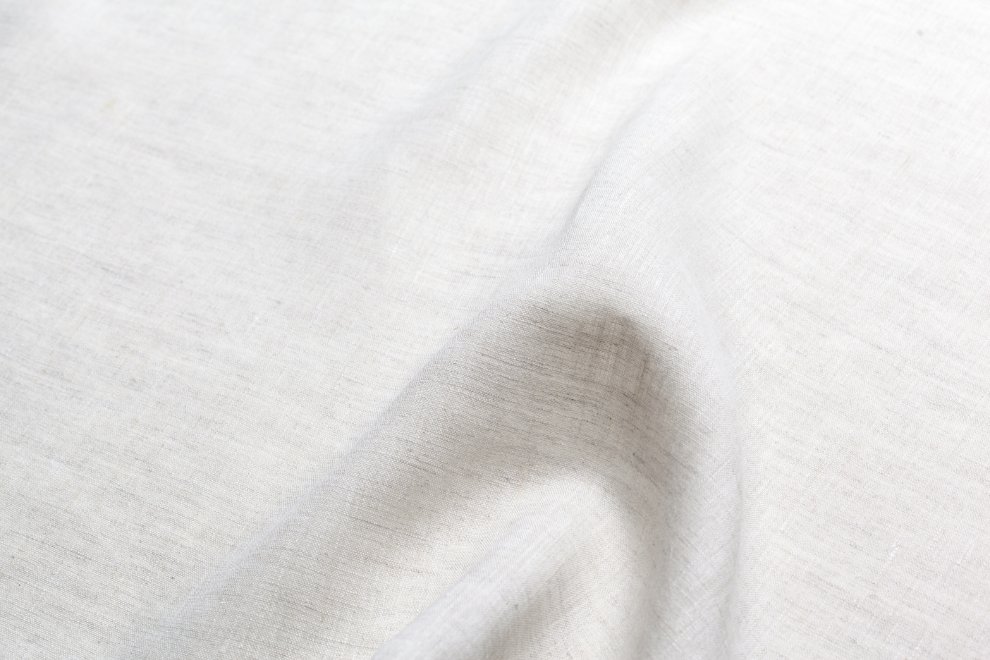
Parents looking for sustainable baby clothing have options beyond organic cotton. Several innovative materials offer excellent properties for infant wear while reducing environmental impact.
Bamboo Fabric Properties
Bamboo fabric has gained popularity in sustainable baby clothing circles. Bamboo grows incredibly fast without pesticides or fertilizers, making it naturally eco-friendly. The fabric feels softer than conventional cotton and has natural moisture-wicking properties.
Bamboo offers several advantages:
- Natural antibacterial and antifungal properties
- Excellent breathability and temperature regulation
- UV protection (UPF 50+)
- Hypoallergenic qualities
- Biodegradable at end of life
However, processing method matters. Mechanically processed bamboo (bamboo linen) is more sustainable than bamboo rayon, which requires chemical processing similar to conventional textiles.
Hemp and Other Natural Fibers
Hemp is making a comeback in baby clothing due to its environmental benefits. Hemp requires minimal water, improves soil health, and naturally resists pests without pesticides. Modern hemp fabrics are soft and become softer with each wash.
Other sustainable alternatives include:
- Organic linen: Highly breathable, perfect for warm weather
- TENCEL/Lyocell: Made from sustainably harvested wood pulp
- Organic wool: Temperature regulating, naturally antimicrobial
- Peace silk: Cruelty-free silk production
Innovative Eco-Friendly Materials
The sustainable fashion industry continues developing exciting alternatives for baby clothing. Recycled materials, including recycled cotton and polyester made from plastic bottles, provide durability while reducing waste.
Emerging sustainable materials include:
- Orange fiber (made from citrus waste)
- Piñatex (pineapple leaf fiber)
- Mushroom leather alternatives
- Algae-based fibers
- Recycled fishing net polyester
Consumer Guide to Buying Infant Clothes
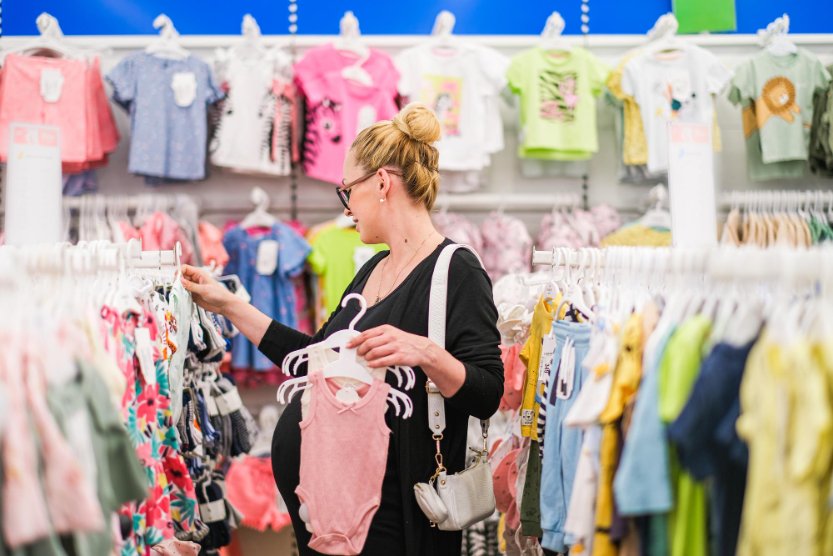
Navigating the world of infant clothing requires understanding certifications, knowing where to shop, and recognizing quality brands that prioritize both safety and sustainability.
Identifying Authentic Organic Products
When shopping for organic baby clothes, always look for trusted certifications. The Global Organic Textile Standard (GOTS) is the gold standard, ensuring products contain at least 95% certified organic fibers and meet strict environmental and social criteria.
Red flags to watch for:
- Vague terms like “natural” or “eco-friendly” without certification
- Prices significantly lower than other organic brands
- Lack of detailed product information
- No mention of manufacturing location
- Absence of care instructions specific to organic fabrics
Should I buy organic for my baby?
The decision to buy organic depends on your priorities and budget. Organic clothing offers clear benefits for babies with sensitive skin, eczema, or allergies. Environmental considerations and supporting sustainable farming practices are additional factors many parents value.
Consider starting with organic options for:
- Items that directly touch skin (onesies, sleepwear)
- Clothing worn for extended periods
- Newborn essentials when skin is most sensitive
- Pieces you plan to use for multiple children
Where to Purchase Quality Organic Infant Clothing
Several reliable sources offer authentic organic infant clothing:
Top Organic Baby Clothing Retailers:
- Specialty baby boutiques: Curated selections with expert guidance
- Direct-to-consumer brands: Better prices and quality control
- Department stores: Major retailers now carry organic lines
- Online marketplaces: Wide selection with customer reviews
- Subscription services: Convenient, often with size exchanges
Need help choosing between brands? Use our safe baby clothing brands comparison tool to evaluate safety ratings, certifications, and parent reviews for top organic brands.
Gender-Neutral and Inclusive Design Trends
Gender-neutral baby clothing is trending significantly, with parents choosing versatile designs that work for any child. This approach offers practical benefits including cost savings for families planning multiple children and support for children’s self-expression.
Popular gender-neutral trends include:
- Earth tones and muted colors
- Nature-inspired prints and patterns
- Minimalist designs with functional features
- Animal themes without gender stereotypes
- Coordinating sibling outfits
Subscription Services and Personalization
Baby clothing subscription services are gaining popularity, offering curated selections based on your baby’s size, season, and style preferences. Many services now offer organic options and size exchange programs.
Benefits of subscription services:
- Automatic size updates as baby grows
- Access to exclusive organic brands
- Reduced shopping time for busy parents
- Often include expert styling advice
- Return/exchange policies for poor fits
Find Your Perfect Organic Fabric Match
Not sure which organic fabric is best for your baby’s specific needs? Our interactive quiz considers your baby’s skin sensitivity, your climate, and lifestyle to recommend the perfect organic fabric.
Frequently Asked Questions
Organic infant clothing offers several key advantages: no harmful chemicals or pesticides that could irritate sensitive baby skin, softer and more breathable fabrics for better temperature regulation, and greater durability for longer wear. The absence of synthetic treatments means reduced risk of allergic reactions, making organic clothing ideal for babies with eczema or sensitive skin conditions.
GOTS certification ensures baby clothes meet strict ecological and social criteria throughout production. This includes verification that no harmful chemicals were used in growing or processing the fabric, prohibition of toxic heavy metals and formaldehyde, and verification of fair labor practices. It’s essentially a comprehensive safety guarantee for parents.
Conventional baby clothes may contain residual pesticides and chemicals like formaldehyde, which could potentially trigger skin irritations or allergic reactions in sensitive babies. Synthetic dyes can contain heavy metals that might be absorbed through skin, and flame retardants in some sleepwear have been linked to hormonal disruptions, though research is ongoing.
Softness should be a priority since babies have sensitive skin. Breathability is crucial to prevent overheating – natural fibers like organic cotton, bamboo, and wool allow better airflow than synthetic materials. Durability matters for frequent washing, and parents should look for strong seams and quality construction that can withstand multiple laundry cycles.
Parents choose organic options to minimize their baby’s exposure to potentially harmful chemicals and pesticides, especially important for babies with sensitive skin. Environmental impact is another factor – many parents want to reduce their carbon footprint and support sustainable farming practices. The ethical aspects of organic production, including better working conditions, also influence purchasing decisions.
Conventional cotton farming uses about 16% of the world’s insecticides despite occupying just 2.5% of agricultural land. Organic production typically uses 88% less water and 62% less energy than conventional methods. The absence of synthetic fertilizers in organic farming helps prevent water pollution and protects biodiversity in farming areas.
Use your baby’s current weight and height rather than age for the most accurate fit, as babies grow at different rates. Consider buying one size up for longer wear, and account for potential shrinkage after washing organic fabrics. Check each brand’s specific size chart, as sizing can vary significantly between manufacturers.
Non-bio detergents don’t contain enzymes that can potentially irritate sensitive skin, making them traditionally preferred for baby clothes. However, many modern bio detergents are formulated to be gentle enough for babies. The most important factors are choosing detergents free from fragrances, dyes, and harsh chemicals, regardless of whether they’re bio or non-bio.
Conclusion
Making the Right Choice for Your Baby
After examining the comprehensive differences between organic and conventional infant clothing, the evidence strongly supports organic options for families who can afford them. The combination of health benefits, environmental protection, and long-term value makes organic baby clothing a worthwhile investment for most parents.
Key Takeaways
Health and Safety: Organic baby clothes eliminate exposure to pesticide residues, synthetic dyes, and harsh processing chemicals that can irritate sensitive infant skin. For babies with eczema, allergies, or particularly sensitive skin, organic clothing often provides noticeable improvement in comfort and reduced reactions.
Environmental Impact: Choosing organic supports farming practices that use 88% less water, eliminate harmful pesticides, and protect biodiversity. This choice contributes to a healthier planet for your child’s future while supporting ethical labor practices throughout the supply chain.
Economic Value: While organic clothing costs 20-30% more initially, the superior durability means these garments last 2-3 times longer than conventional alternatives. When calculated per wear, organic clothes often cost the same or less, especially when passed down to siblings or resold.
Practical Recommendations
Start Strategic: If budget is a concern, prioritize organic purchases for items that have direct skin contact – onesies, sleepwear, and bodysuits. You can mix organic basics with conventional outer layers to balance cost and benefits. Our age-specific clothing checklist helps you prioritize which organic items to buy first for maximum impact.
Look for Certifications: Always choose GOTS-certified organic clothing when possible, and supplement with OEKO-TEX Standard 100 certified items for additional safety assurance. These certifications provide the strongest guarantee of product safety and environmental responsibility. Compare safety ratings and certifications across brands using our comprehensive brand comparison tool.
Plan for Growth: Buy organic clothing in the next size up to maximize wear time, and consider gender-neutral options if you plan to have more children. This approach maximizes your investment while supporting sustainable consumption patterns.
Care Properly: Extend the life of organic clothing through proper care – wash in cold water with fragrance-free detergent, air dry when possible, and store in breathable containers. Proper cotton care ensures these garments maintain their quality through multiple children.
Future Considerations
The baby clothing industry is evolving rapidly, with smart fabrics and innovative sustainable materials offering new possibilities. Stay informed about emerging technologies like embedded health sensors in organic fabrics, which may provide additional value for monitoring your baby’s wellbeing.
As the market grows, organic options are becoming more accessible and affordable. Support brands that prioritize transparency in their supply chains and invest in research for safer, more sustainable materials.
Final Recommendation: For most families, the benefits of organic infant clothing – reduced chemical exposure, environmental protection, and long-term value – justify the higher initial investment. Start with essential items, prioritize certified products, and view organic clothing as an investment in your child’s health and future. Your baby’s sensitive skin, developing immune system, and the planet they’ll inherit all benefit from this conscious choice.
Ready to Start Your Organic Baby Clothing Journey?
Use our interactive tools to make informed decisions about your baby’s organic clothing needs.

